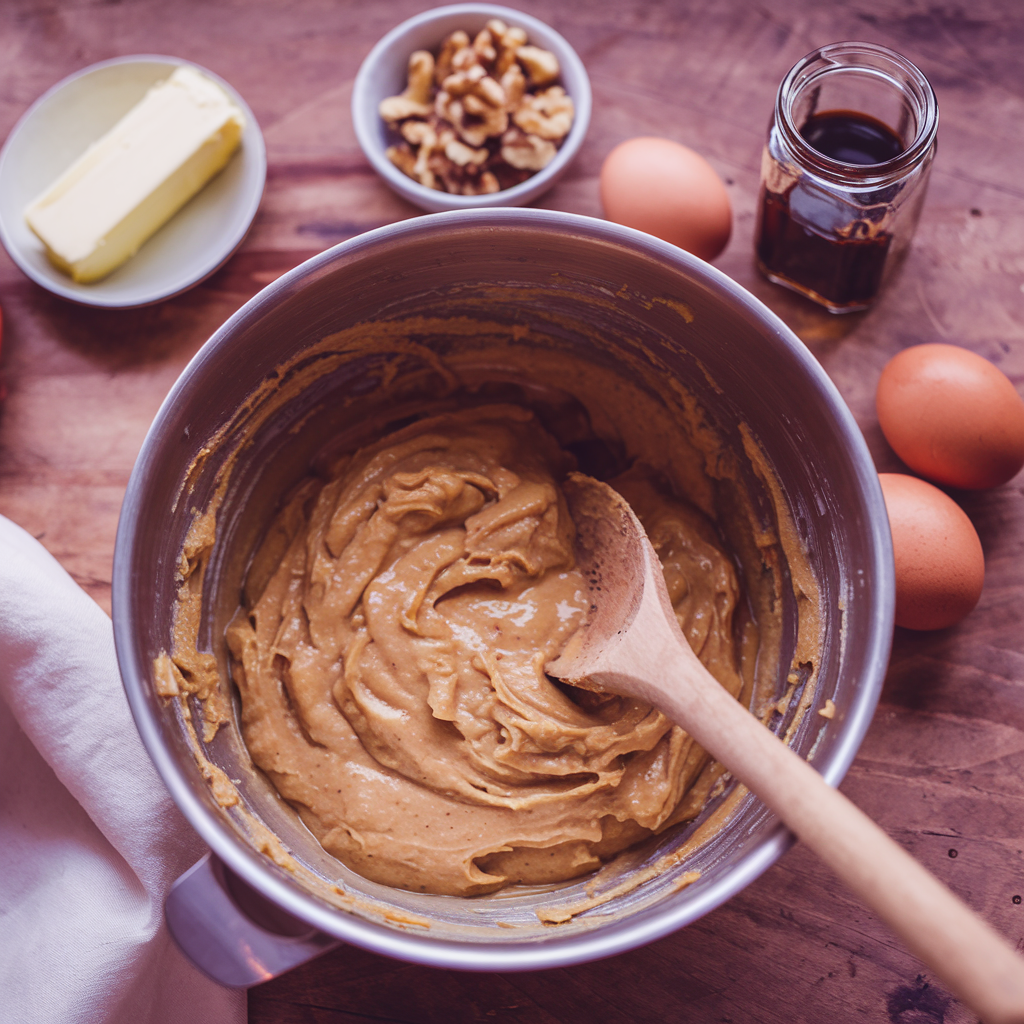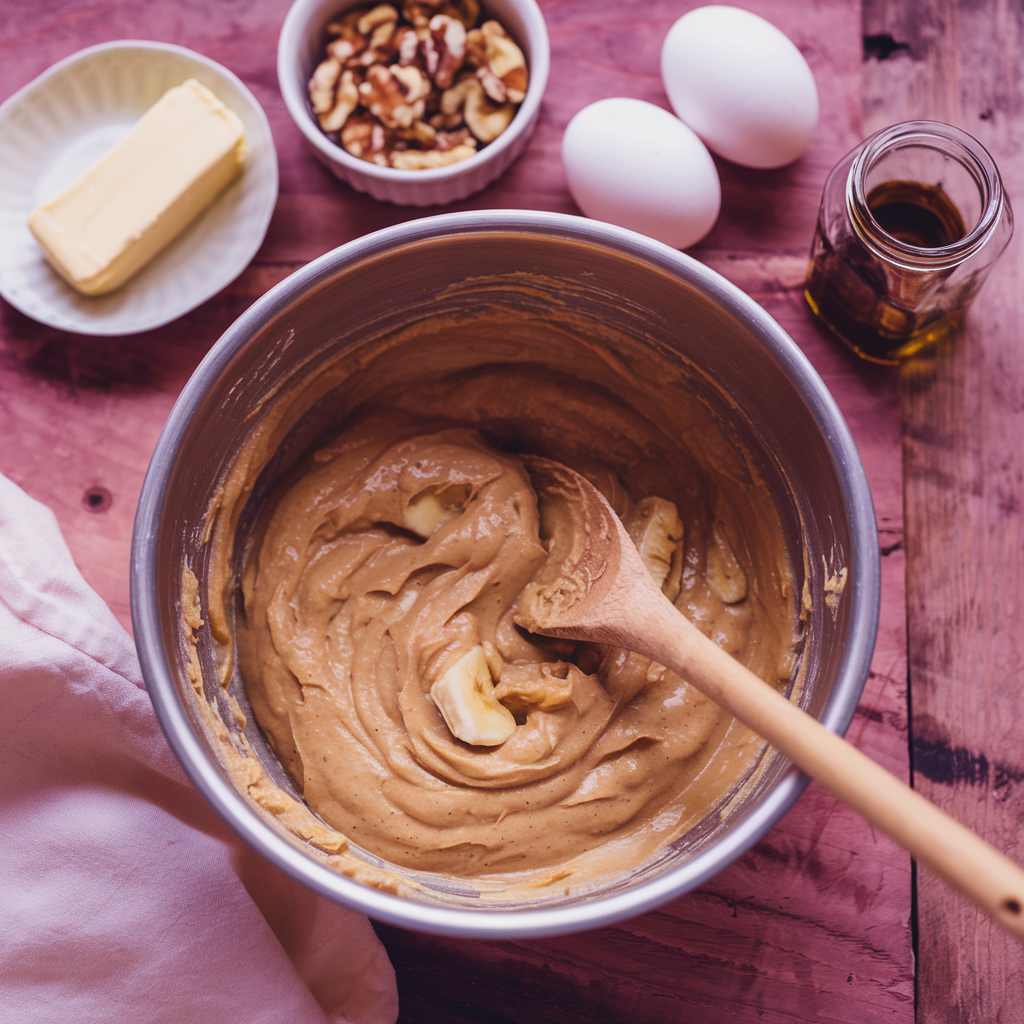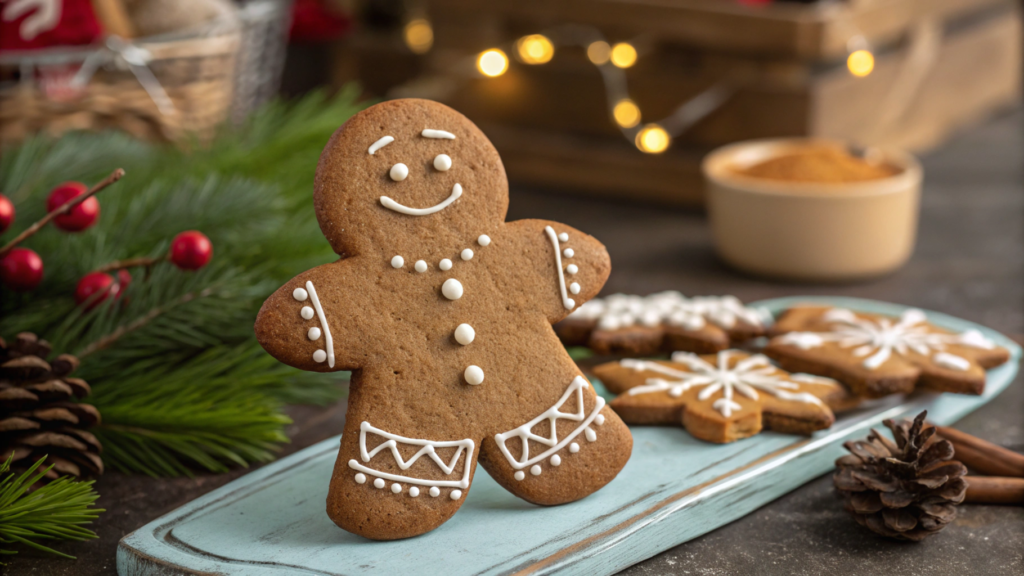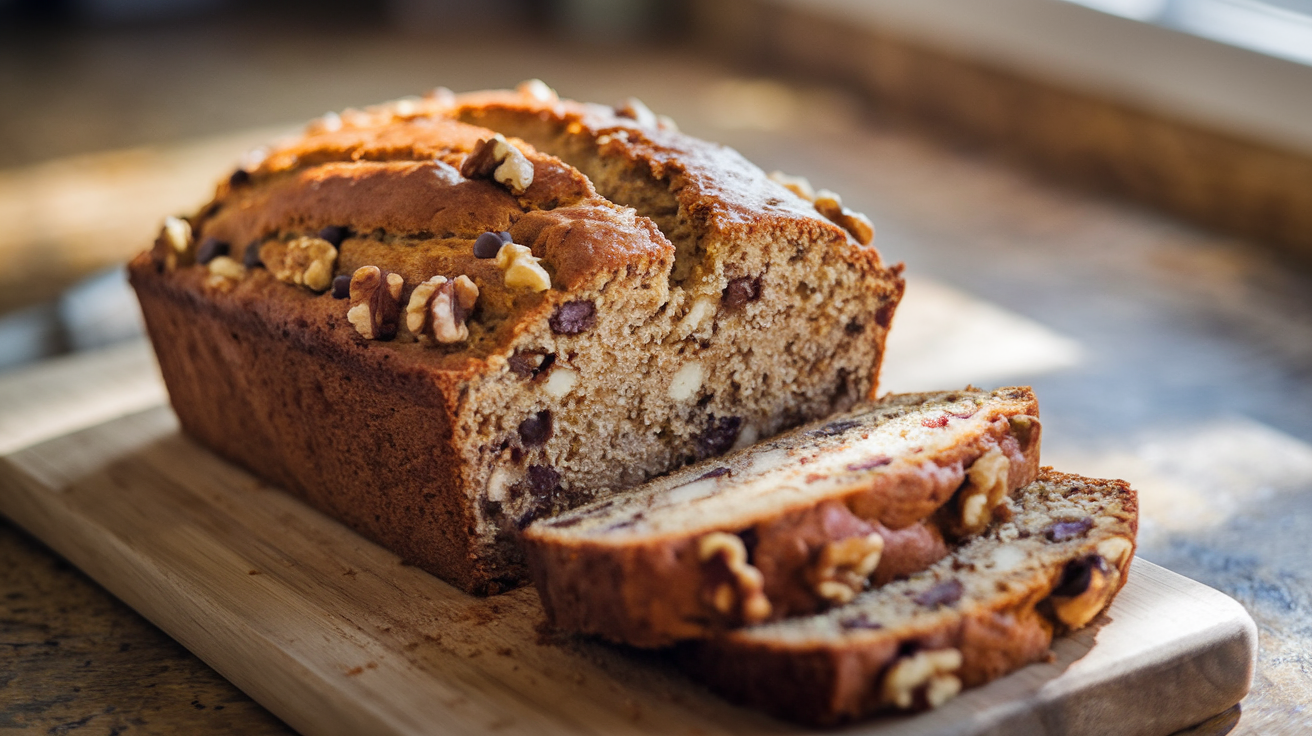Introduction to Banana Bread
Banana bread is a beloved classic that has stood the test of time in kitchens worldwide. But what makes it so special? It’s easy to make, incredibly versatile, and perfect for using up those overripe bananas sitting on your counter. Plus, the aroma of freshly baked banana bread fills your home with a cozy, welcoming vibe that’s hard to beat.
Whether you’re an experienced baker or just dipping your toes into the world of baking, an easy banana bread recipe is an essential addition to your culinary repertoire. In this guide, we’ll dive into everything you need to know about making banana bread, from the must-have ingredients to pro tips for storage and pairing. So grab those bananas, and let’s get started!
Banana bread has a history that’s as comforting as its flavor. It gained popularity during the Great Depression when no food went to waste—especially ripe bananas. Over time, it has evolved from a frugal kitchen staple to a modern favorite. Today, it’s a perfect balance of nostalgia and innovation, allowing bakers to adapt recipes with creative twists. Whether it’s for breakfast, a snack, or dessert, banana bread fits every occasion.
Essential Ingredients for Easy Banana Bread
Creating the perfect banana bread starts with assembling the right ingredients. Here’s what you’ll need:
- Bananas: Overripe bananas are the star of this dish, offering natural sweetness and moisture.
- Flour: All-purpose flour works best for a traditional loaf.
- Sugar: Granulated sugar or brown sugar adds sweetness. Brown sugar gives a richer flavor.
- Butter: Unsalted butter provides a creamy texture and buttery taste.
- Eggs: These bind the ingredients together and add structure.
- Baking soda: This helps the bread rise and keeps it light.
- Salt: A pinch of salt enhances the flavor.
- Vanilla extract: This adds depth and enhances the banana flavor.
Optional ingredients include:
- Nuts: Walnuts or pecans for added crunch.
- Chocolate chips: For a sweeter, dessert-like twist.
- Spices: Cinnamon or nutmeg for warmth.
Why Ingredient Quality Matters
Using fresh, high-quality ingredients is crucial for a successful banana bread. For example:
- Flour: Check the expiration date to ensure it hasn’t gone stale. Fresh flour impacts the bread’s texture and rise.
- Butter: Room-temperature butter creams better with sugar, creating a light, fluffy texture.
- Bananas: Fully ripe bananas with black spots are ideal. Their natural sugars caramelize during baking, enhancing the flavor.
Don’t overlook these details—they can make or break your easy banana bread recipe.
Tools You Need to Make Banana Bread
Having the right tools on hand makes baking an easy banana bread recipe a breeze. Here are the essentials:
- Mixing bowls: A set of large and medium-sized bowls.
- Measuring cups and spoons: For precise measurements.
- Fork or potato masher: To mash the bananas.
- Whisk or electric mixer: For mixing the batter evenly.
- Loaf pan: A standard 9×5-inch loaf pan is ideal.
- Spatula: To scrape down the bowl and transfer the batter.
- Cooling rack: Ensures the bread cools evenly.
Optional Tools for Convenience
- Stand mixer: Makes mixing faster and easier.
- Parchment paper: Simplifies cleanup and ensures the bread is released easily from the pan.
- Digital scale: For more accurate measurements, especially with dry ingredients.
Pro tip: Always grease your loaf pan with butter or line it with parchment paper to prevent sticking. If you bake often, investing in quality non-stick bakeware is worth considering.

Step-by-Step Guide to Making Banana Bread
Choosing and Preparing Bananas
The key to a moist and flavorful easy banana bread recipe lies in the bananas. Follow these tips:
- Ripeness matters: Use bananas that are heavily spotted or even blackened. These are sweeter and easier to mash.
- Mashing method: Use a fork or potato masher to create a smooth yet slightly chunky consistency. Avoid over-pureeing as a bit of texture adds to the bread.
- Storage tip: If your bananas aren’t ripe enough, place them in a paper bag to speed up the process. Alternatively, roast them in the oven at 300°F for 15 minutes.
Mixing the Batter
- Cream the butter and sugar: Beat softened butter with sugar until light and fluffy. This ensures a tender crumb.
- Add eggs and vanilla: Mix in the eggs one at a time, followed by the vanilla extract.
- Combine dry ingredients: In a separate bowl, whisk together flour, baking soda, and salt.
- Incorporate bananas: Fold the mashed bananas into the wet mixture.
- Blend it all: Gradually add the dry ingredients to the wet mixture, stirring just until combined. Overmixing can make the bread dense.
Baking Your Banana Bread
- Prepare the pan: Grease or line your loaf pan.
- Pour the batter: Fill the pan evenly and smooth the top with a spatula.
- Bake: Preheat your oven to 350°F and bake for 50-60 minutes. Insert a toothpick into the center; it should come out clean when done.
- Cool: Let the bread cool in the pan for 10 minutes before transferring it to a cooling rack.
Variations of Banana Bread
Banana bread’s versatility allows for endless creative variations. Here are a few ideas:
- Chocolate chip banana bread: Add a cup of chocolate chips for a sweet twist.
- Nutty banana bread: Fold in chopped walnuts or pecans for crunch.
- Spiced banana bread: Mix in cinnamon, nutmeg, or ginger for a warm, spiced flavor.
- Banana blueberry bread: Fresh or frozen blueberries make for a juicy addition.
- Gluten-free banana bread: Swap all-purpose flour for a gluten-free blend.
Creative Combinations
- Banana coconut bread: Add shredded coconut and a splash of coconut milk.
- Peanut butter banana bread: Swirl peanut butter into the batter before baking.
- Carrot-banana bread: Incorporate grated carrots for a cross between banana bread and carrot cake.
Experiment with different flavors and textures to find your favorite combination.
Healthy Alternatives for Banana Bread
Want to make a healthier version of your easy banana bread recipe? Here are some substitutions:
- Flour: Use whole wheat or almond flour for added nutrients.
- Sugar: Replace sugar with honey, maple syrup, or coconut sugar.
- Butter: Substitute with coconut oil or applesauce for a lower-fat option.
- Eggs: Try flaxseed or chia seed eggs for a plant-based alternative.
- Add-ins: Incorporate oats, flaxseed, or shredded zucchini for extra fiber.
Balancing Flavor and Nutrition
These swaps let you enjoy banana bread guilt-free while maintaining great taste. Try a combination of healthy alternatives to match your dietary preferences while keeping the loaf moist and flavorful.
Common Mistakes to Avoid When Making Banana Bread
Avoid these pitfalls to ensure perfect banana bread every time:
- Using unripe bananas: These lack the sweetness and moisture needed.
- Overmixing the batter: This can make the bread dense and tough.
- Skipping the greasing step: Always grease your pan to prevent sticking.
- Overbaking: Keep an eye on your bread and test for doneness early.
- Improper measurements: Baking is a science; precise measurements are crucial.
Pro Tips for Success
- Use room-temperature ingredients for better mixing.
- Always preheat your oven to ensure even baking.
- Rotate the loaf pan halfway through baking for consistent results.
Learning from these mistakes helps you master the art of banana bread.
Make-Ahead and Storage Tips
Banana bread is a great make-ahead treat. Here’s how to store it properly:
- At room temperature: Wrap the cooled loaf tightly in plastic wrap or foil and store for up to 3 days.
- In the refrigerator: Store in an airtight container for up to a week.
- Freezing: Wrap slices individually in plastic wrap and place them in a freezer bag. Thaw slices at room temperature or warm them in the microwave.
Maximizing Freshness
- Reheat carefully: Warm slices in the oven or microwave to revive the fresh-baked taste.
- Avoid refrigeration for short-term storage: Refrigeration can dry out banana bread unless it’s well-wrapped.
Prepping ahead makes it easy to enjoy banana bread anytime.
Pairing Banana Bread with Beverages and Sides
Banana bread pairs wonderfully with a variety of drinks and sides. Some favorites include:
- Coffee or tea: A warm beverage complements the bread’s sweetness.
- Milk: A classic pairing, especially for kids.
- Yogurt or cream cheese: Spread a dollop for a creamy contrast.
- Fruit: Fresh berries or sliced apples add a refreshing touch.
Creative Pairings
- Smoothies: Pair banana bread with a green or fruity smoothie for a balanced snack.
- Ice cream: Serve warm slices with a scoop of vanilla ice cream for dessert.
These pairings make banana bread even more delightful.

FAQ: All About Banana Bread
What is the formula for banana bread?
The basic formula for banana bread is straightforward and relies on a balance of wet and dry ingredients. A classic easy banana bread recipe includes:
- 2-3 overripe bananas: These provide natural sweetness and moisture.
- 1 1/2 to 2 cups of flour: All-purpose flour is most common.
- 1 cup of sugar: Adjust based on your desired sweetness.
- 1/2 cup of butter: For richness and texture.
- 1 egg: Acts as a binding agent.
- 1 teaspoon of baking soda: Helps the bread rise.
- Pinch of salt: Enhances flavors.
Mix wet ingredients with dry ingredients gently to avoid overmixing, which can make the bread dense.
Should I use baking soda or baking powder for banana bread?
Baking soda is typically used in banana bread recipes because it reacts with the acidity of the bananas, creating carbon dioxide bubbles that help the bread rise. Baking powder, while a leavening agent, is better suited for recipes without acidic ingredients. If you substitute baking powder, use three times the amount of baking soda required in the recipe for similar results.
Is it better to bake banana bread in a glass or metal pan?
Both options work, but they have distinct differences:
- Glass pans: These distribute heat more slowly, which may result in a longer bake time. However, glass retains heat, which helps the bread continue cooking evenly after it’s removed from the oven.
- Metal pans: Conduct heat more efficiently, leading to quicker and more even baking. Non-stick metal pans are especially popular for banana bread.
For the best results, adjust your bake time based on the material of your pan and check for doneness with a toothpick.
What is unhealthy about banana bread?
Traditional banana bread recipes can be high in:
- Sugar: Recipes often call for a full cup or more.
- Butter: Adds fat and calories.
- Refined flour: Lacks fiber and nutrients.
To make a healthier version, reduce sugar, use whole wheat or almond flour, and substitute butter with healthier fats like coconut oil or applesauce. Incorporating add-ins like nuts or seeds can also boost nutritional value.
Do baking soda and baking powder work the same?
No, they are not interchangeable. Baking soda is a single-ingredient leavening agent that requires an acidic component to activate. Baking powder, on the other hand, contains both an acid and a base, meaning it works without added acidity. Understanding their roles ensures proper texture and rise in baked goods.
Will too much baking soda ruin banana bread?
Yes, too much baking soda can harm banana bread. Excess baking soda can:
- Create a metallic or soapy aftertaste.
- Cause the bread to rise too quickly and then collapse.
- Result in an uneven or overly dense texture.
Stick to the recipe’s specified amount for the best results.
What makes bread fluffy: baking soda or powder?
Both can contribute to fluffiness, but their roles differ:
- Baking soda: Reacts quickly with acidic ingredients, creating gas bubbles that expand during baking.
- Baking powder: Has a slower release of gas, often leading to a more even and sustained rise.
In banana bread, the combination of mashed bananas and baking soda is what makes it moist and fluffy.
Why does my banana bread get so dark?
Dark banana bread may result from:
- Overripe bananas: Their natural sugars caramelize during baking.
- High sugar content: Excess sugar can cause the crust to darken faster.
- Oven temperature: A slightly high temperature can overbrown the outside while the inside is still baking.
Reduce the sugar slightly or cover the bread with foil during the last 15 minutes of baking to prevent over-browning.
What can I substitute for 1 teaspoon of baking soda in banana bread?
If you’re out of baking soda, you can substitute with:
- Baking powder: Use 3 teaspoons of baking powder for every 1 teaspoon of baking soda.
- Self-rising flour: It already contains a leavening agent, so adjust the recipe accordingly.
- Potassium bicarbonate: A sodium-free alternative with a similar function to baking soda.
These substitutions may slightly alter the texture or flavor, but they will still yield a delicious loaf.

Conclusion: Why Banana Bread Is a Must-Try Recipe
Banana bread is more than just a way to use up ripe bananas; it’s a timeless recipe that brings comfort and joy. Its simplicity, versatility, and delicious flavor make it a go-to for bakers of all levels. Whether you’re baking for yourself, your family, or guests, banana bread never disappoints.
With this comprehensive guide, you can tackle any easy banana bread recipe and make it your own. From classic versions to creative twists, there’s no limit to what you can do. So what are you waiting for? It’s time to preheat that oven and bake something amazing!

1 réflexion au sujet de « Easy Banana Bread Recipe: A Classic You’ll Love »